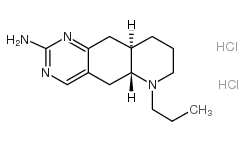Quinelorane hydrochloride

Quinelorane hydrochloride structure
|
Common Name | Quinelorane hydrochloride | ||
|---|---|---|---|---|
| CAS Number | 97548-97-5 | Molecular Weight | 319.27300 | |
| Density | N/A | Boiling Point | 438.5ºC at 760 mmHg | |
| Molecular Formula | C14H24Cl2N4 | Melting Point | N/A | |
| MSDS | Chinese USA | Flash Point | 219ºC | |
Use of Quinelorane hydrochlorideQuinelorane dihydrochloride (LY163502) is a potent dopamine D3/D2 receptor agonist. Quinelorane has the potential for neurological and psychiatric disorders research[1][2]. |
| Name | (5aR,9aR)-6-propyl-5a,7,8,9,9a,10-hexahydro-5H-pyrido[2,3-g]quinazolin-2-amine,dihydrochloride |
|---|---|
| Synonym | More Synonyms |
| Description | Quinelorane dihydrochloride (LY163502) is a potent dopamine D3/D2 receptor agonist. Quinelorane has the potential for neurological and psychiatric disorders research[1][2]. |
|---|---|
| Related Catalog | |
| Target |
D2 Receptor D3 Receptor |
| In Vivo | Quinelorane dihydrochloride (LY163502; 0.003, 0.01 mg/kg; s.c.) reduces GABA efflux, with significant effects with 0.01 but not 0.003 mg/kg in male Wistar rats (300 g)[1]. Quinelorane dihydrochloride (0.032, 0.32, 3.2, 5.6 mg/kg; IP) significantly and dose-dependently increases locomotor activity in the Sprague Dawley rats. There was no main effect of sex and sex interaction[1]. Quinelorane dihydrochloride significantly decreases activity in the male and female inbred FVB/NJ, BALB/cJ, BALB/cByJ, C57BL/6J, Swiss Webster, A/J, DBA/2J, 129S1/SvImJ, and 129S6/SvEvTac mice[1]. |
| References |
| Boiling Point | 438.5ºC at 760 mmHg |
|---|---|
| Molecular Formula | C14H24Cl2N4 |
| Molecular Weight | 319.27300 |
| Flash Point | 219ºC |
| Exact Mass | 318.13800 |
| PSA | 55.04000 |
| LogP | 3.77110 |
| Personal Protective Equipment | Eyeshields;Gloves;type N95 (US);type P1 (EN143) respirator filter |
|---|---|
| RIDADR | NONH for all modes of transport |
|
Effects of the selective dopaminergic D2 agonist quinelorane on the activity of dopaminergic and noradrenergic neurons projecting to the diencephalon of the rat.
J. Pharmacol. Exp. Ther. 268 , 645, (1994) The purpose of the present study was to characterize dopaminergic D2 receptor-mediated regulation of catecholaminergic neurons in the diencephalon by examining the acute effects of the potent and sele... |
|
|
Effects of LY163502, a D2 dopaminergic agonist, on the sexual behavior of male rats.
Pharmacol. Biochem. Behav. 43 , 1087, (1992) LY163502, a selective D2 receptor agonist, has been reported to stimulate sexual behavior in both copulating and noncopulating male rats. Three experiments were conducted to further characterize the r... |
|
|
Oscillation of interspike interval length in substantia nigra dopamine neurons: effects of nicotine and the dopaminergic D2 agonist LY 163502 on electrophysiological activity.
Synapse 11 , 229, (1992) The rates and patterns of discharge activity exhibited by 16 spontaneously active substantia nigra pars compacta dopamine neurons were studied in halothane-anesthetized rats using three types of quant... |
| Quinelorane HCl |
| Quinelorane dihydrochloride |
| LY-163,502 |
| Quinerlorane hydrochloride |